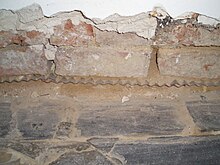Methods of Damp Proofing
– Installing a damp-proof course (DPC) to prevent moisture rising through capillary action.
– Applying a damp-proof membrane (DPM) to prevent moisture transmission.
– Incorporating integral damp proofing in concrete to make it impermeable.
– Using surface suppressant coating with waterproof materials like epoxy resin or cement.
– Implementing cavity wall construction, such as rainscreen construction.
– Pressure grouting cracks and joints in masonry materials.
Materials Used for Damp Proofing
– Flexible materials like butyl rubber, hot bitumen, plastic sheets, and bituminous felts.
– Semi-rigid materials like mastic asphalt.
– Rigid materials like impervious brick, stone, slate, and cement mortar.
– Stones and mortar with waterproofing compounds.
– Coarse sand layers and continuous plastic sheets under floors.
Damp Proofing in Masonry Construction
– Installing a durable, impermeable DPC or DPM between courses of bricks or blocks.
– Using a cavity wall construction with a DPC in both the outer and inner wall.
– Placing the DPC in the outer wall above ground level to prevent saturation.
– Positioning the DPC in the inner wall below floor level or above the floor slab.
– Utilizing a one-piece length of rigid plastic (cavity tray) across the cavity.
Damp Proofing in Concrete Walls and Floors
– Concrete walls and floors require a vertical vapor barrier to prevent moisture penetration.
– Barriers can be in the form of coatings or membranes applied to the exterior of the concrete.
– Coatings may include asphalt, asphalt emulsion, cutback asphalt, or elastomers.
– Membranes are typically rubberized asphalt or EPDM rubber for better crack resistance.
– Vertical vapor barriers are necessary due to concrete’s permeability to moisture.
Remedial Damp Proofing
– Dampness in older buildings can be addressed using various solutions depending on the type of dampness.
– Common causes of damp stains on internal walls in older buildings include leaking rainwater gutters, misdirected rainwater downpipes, insufficient external drainage, poor drip details, and bridging of the damp proof course.
– Different types of dampness that may affect buildings include rising damp, hygroscopic damp, condensation, and penetrating damp.
– Proper diagnosis of the dampness issue is crucial in determining the appropriate remedial damp proofing method.
– Addressing external factors and ensuring proper drainage can help mitigate dampness in existing buildings. Source: https://en.wikipedia.org/wiki/Damp_proofing
This article needs additional citations for verification. (February 2014) |
Damp proofing in construction is a type of moisture control applied to building walls and floors to prevent moisture from passing into the interior spaces. Dampness problems are among the most frequent problems encountered in residences.


Damp proofing is defined by the American Society for Testing and Materials (ASTM) as a material that resists the passage of water with no hydrostatic pressure. Waterproof is defined by the ASTM as a treatment that resists the passage of water under pressure. Generally, damp proofing keeps exterior moisture from entering a building; vapor barriers, a separate category, keep interior moisture from getting into walls. Moisture resistance is not necessarily absolute; it is usually stated in terms of acceptable limits based on engineering tolerances and a specific test method.
